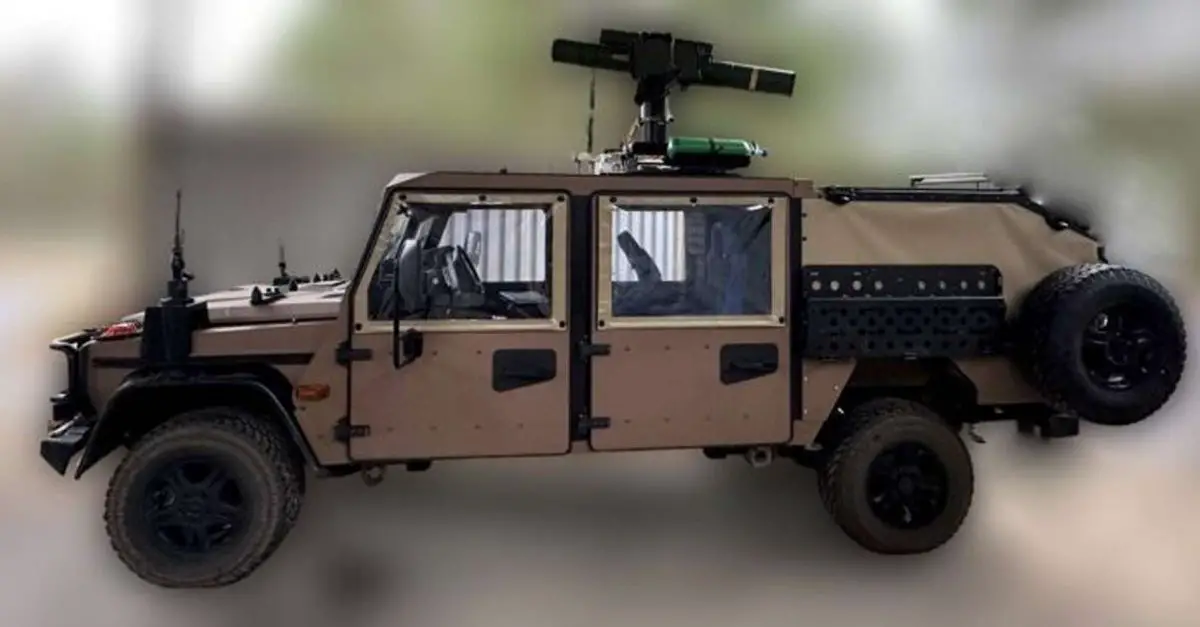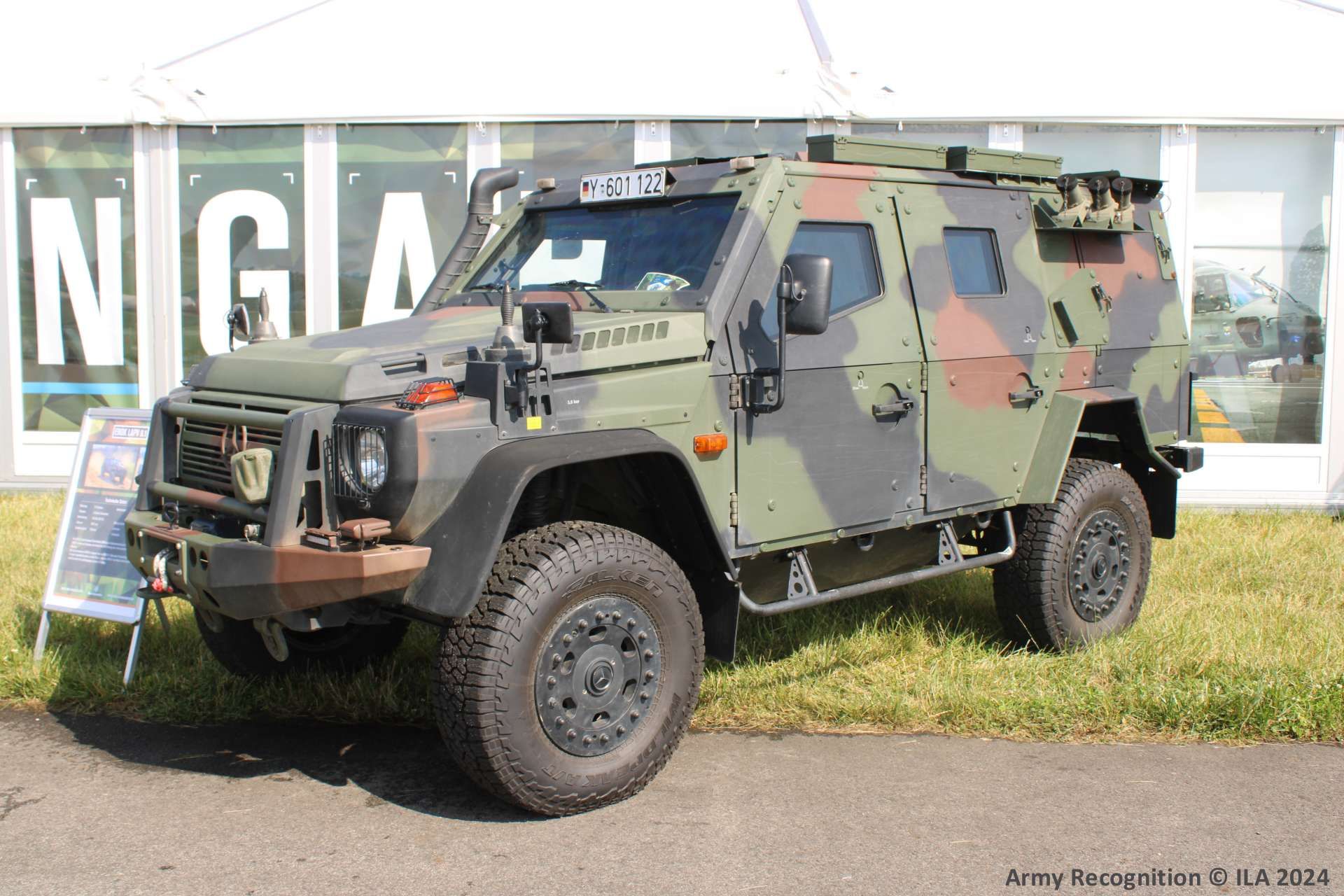Breaking News
Cyprus receives first of 60 Enok AB anti-tank vehicles armed with Spike LR2 missiles.
On August 7, 2024, Flight.gr published the first image of the ENOK 4.8 AB airborne vehicle ordered by the Cypriot National Guard, which is designed to carry the Spike LR2 anti-tank guided missile. This vehicle, part of a 60-unit order placed by Cyprus last year, has been completed and is currently undergoing testing. As of now, it remains unclear whether all vehicles in the order will be equipped with Spike LR2 launchers.
Follow Army Recognition on Google News at this link

Among the Enok's configurations is the anti-tank "Tankhunter" variant, which is equipped with Spike guided missiles and has recently entered mass production. (Picture source: Flight.gr)
The Enok vehicle, on which this variant is based, was developed during Germany's military modernization efforts in the early 2000s. Originating from the Mercedes-Benz G-Class platform, the Enok was intended to replace older models like the Wolf SSA. Since its introduction, the Enok has been produced in several versions, including the Enok 5.4 and Enok 6.1, which feature improved armor and upgraded capabilities. These versions have been integrated into various roles within the German Army (the Bundeswehr), such as patrol duties, military policing, and explosive ordnance disposal. Additionally, other German security forces have adopted the Enok for specialized uses, demonstrating its versatility in different mission scenarios.
Also known as the Light Armoured Patrol Vehicle (LAPV), the Enok is built to operate in various environments, powered by a diesel engine that provides a top speed of 120 km/h and the ability to traverse gradients up to 60%. The vehicle's protection level, which can reach up to STANAG 1, offers resistance to small arms fire and shrapnel. Like the Caracal, the design of the Enok allows for customization, enabling it to be configured for different military tasks, ranging from conventional patrol operations to more specialized roles. Despite its armored structure, the vehicle is capable of navigating off-road terrains, making it applicable to a wide range of operational contexts.
The ENOK AB variant is a lighter, airborne-compatible version developed by ACS Armoured Car Systems. This model is designed for rapid deployment and can be transported by helicopters like the Chinook. Among its configurations is the anti-tank "Tankhunter" model, which is equipped with Spike guided missiles and has recently entered mass production. This variant maintains the modular design approach seen in the Enok series, allowing it to be adapted for different roles such as fire support and reconnaissance.

Originating from the Mercedes-Benz G-Class platform, the Enok has been produced in several versions, including the Enok 5.4 and Enok 6.1, which feature improved armor and upgraded capabilities. (Picture source: Army Recognition)
The National Guard of Cyprus expressed interest in 5th-generation anti-tank missiles as early as 2021, exploring options from both the European market and Israel. This interest was documented in a 2021 report by the Ministry of Defence under the former Minister of Defence, Charalambos Petridis. In 2023, Cyprus finalized an agreement to acquire the Israeli Spike LR2 anti-tank missiles from the EuroSpike consortium, which includes Rafael Advanced Defense Systems, Diehl, and Rheinmetall. This agreement was initially shared by EuroSpike representatives at the DEFEA 2023 event and was later confirmed during a Defense and Security conference held in Nicosia on May 15-16, 2023.
The Spike missile series, developed by Israel's Rafael Advanced Defense Systems, was designed in response to the need for a versatile and effective anti-tank guided missile (ATGM) system. First introduced in the late 20th century, the Spike system was developed to address modern armored threats, with features such as "fire-and-forget" capability and precision guidance, making it suitable for various combat scenarios. Over time, the Spike family expanded and evolved, leading to adoption across multiple countries, particularly in Europe. This expansion was facilitated by the establishment of EuroSpike, a joint venture with Diehl Defense and Rheinmetall, which helped promote SPIKE missile systems in Europe and produce parts of these systems in Germany.

The Spike LR2 features two warhead options: a tandem HEAT warhead for countering reactive armor and a multipurpose warhead for breaching fortified structures. (Picture source: Army Recognition)
The development of the Spike missile series has resulted in several variants, each tailored for specific operational roles. These include the Spike SR (Short Range) for close-quarters combat, the Spike LR (Long Range) and LR2 for extended engagements, the Spike ER (Extended Range), and the Spike NLOS (Non-Line-Of-Sight) for beyond-visual-range targets.
The Spike LR2, the latest iteration, builds on the capabilities of earlier models with enhancements in range, lethality, and armor penetration. It features two warhead options: a tandem HEAT warhead for countering reactive armor and a multipurpose warhead for breaching fortified structures. The Spike LR2 is also backward-compatible with older Spike systems, allowing for integration into existing arsenals.
The Spike LR2 is equipped with advanced electro-optical guidance, which includes both uncooled infrared and high-definition day sensors, enabling it to engage targets at distances up to 5.5 kilometers when launched from the ground or 10 kilometers from a helicopter. The missile weighs 12.7 kilograms, providing portability while maintaining combat effectiveness. The fiber-optic data link allows operators to update target information in real time, offering flexibility in dynamic combat environments. Furthermore, the Spike LR2 has demonstrated accuracy and effectiveness in engaging a variety of targets, including moving and concealed threats.


























